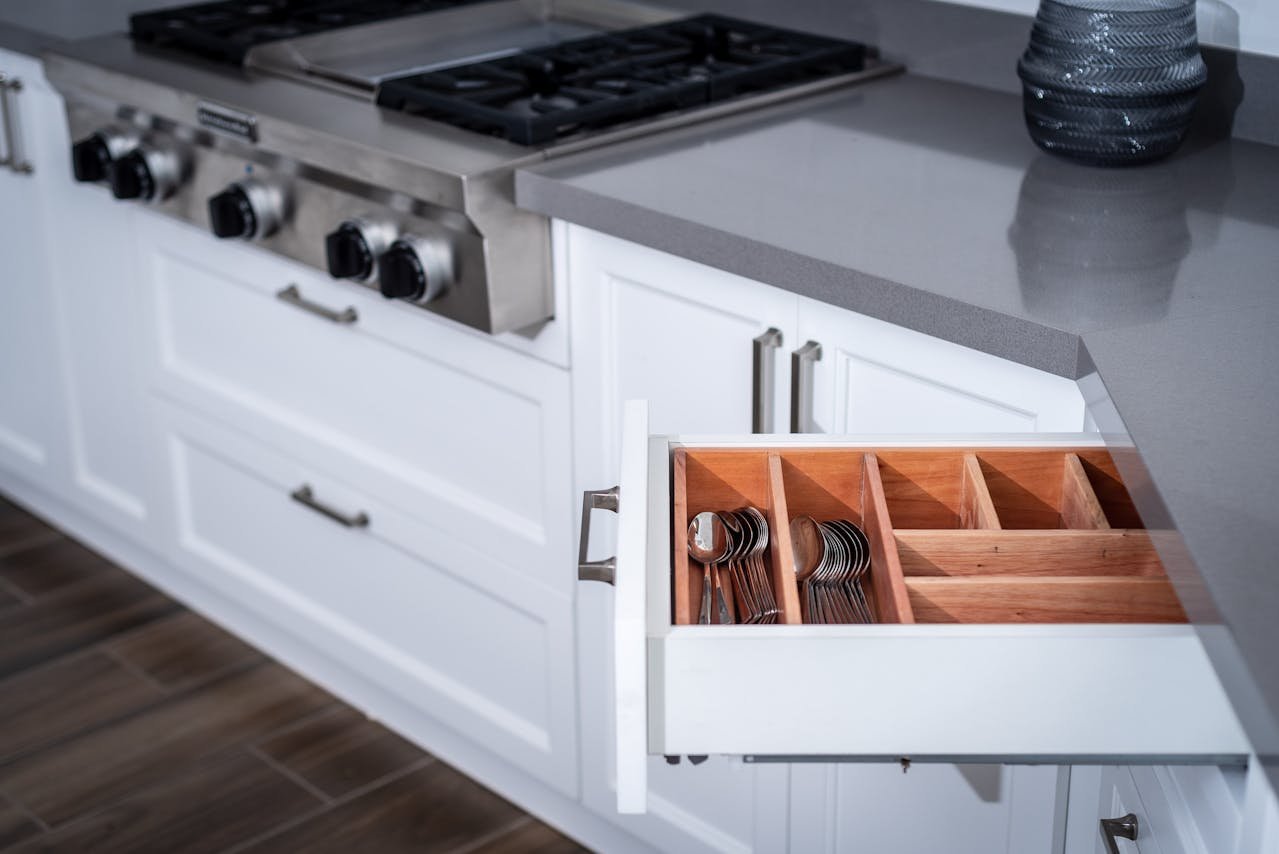After managing residential properties and consulting on kitchen optimization for over thirty-four years, I’ve discovered that the best cutlery organizers for neat and easy access drawers represent far more than simple storage solutions—they’re strategic investments in daily efficiency and kitchen functionality that most people completely underestimate. The wrong organizer choice can create ongoing frustration, waste valuable preparation time, and force expensive replacements when functionality issues become apparent.
What separates successful cutlery organization from disappointing purchases is understanding the relationship between material durability, size optimization, and access patterns that either enhance or restrict daily kitchen workflow. I’ve witnessed countless situations where homeowners invested in attractive but impractical organizers that couldn’t accommodate their actual utensil collections or created maintenance challenges due to poor design engineering.
The reality is that creating truly efficient and accessible cutlery storage requires strategic organizer selection based on proven workflow principles rather than aesthetic preferences alone. The best cutlery organizers for neat and easy access drawers must deliver measurable performance across multiple categories—space efficiency, material quality, accessibility optimization, and long-term durability—while accommodating various kitchen sizes and cooking styles. From compact apartments to spacious culinary environments, I’ve seen how thoughtful organizer choices can transform chaotic drawers into efficient storage systems through sophisticated space planning and strategic organization design.
Material Engineering and Durability Performance Standards
Look, the science behind cutlery organizer materials isn’t subjective—quality construction determines both longevity and daily functionality in ways that separate professional-grade organization from consumer alternatives. The best cutlery organizers for neat and easy access drawers utilize premium materials like solid bamboo, high-grade plastic, and quality hardwood that resist warping, cracking, and general wear while maintaining precise compartment dimensions through years of daily use. What I’ve learned from kitchen efficiency specialists is that material quality directly correlates with both drawer organization effectiveness and user satisfaction over extended periods. Cheap materials develop structural issues, lose shape integrity, and create sliding problems that undermine organization regardless of initial appearance. Smart buyers prioritize proven materials with documented durability testing rather than trendy options that may deteriorate quickly under normal kitchen conditions and frequent drawer operation cycles.
Size Customization and Drawer Fit Optimization
Here’s what most people get wrong about organizer sizing: they choose standard dimensions rather than understanding expandable systems and custom fit requirements that determine whether organizers maximize drawer space or create frustrating gaps and accessibility issues. The best cutlery organizers for neat and easy access drawers feature adjustable components and expandable designs that adapt to specific drawer dimensions while maintaining optimal compartment spacing and utensil accessibility. Expandable bamboo systems typically adjust from 13-20 inches in length, accommodating various drawer sizes while maintaining structural integrity. What consistently works across different kitchen configurations is choosing organizers with flexible sizing that fills drawer space efficiently while providing appropriate compartment dimensions for actual utensil collections. Quality sizing optimization includes consideration of drawer depth, height clearance, and operational space requirements that enhance rather than complicate daily kitchen workflow and utensil retrieval patterns during meal preparation activities.
Compartment Configuration and Organization Psychology
Most people underestimate how dramatically compartment design affects retrieval efficiency and maintenance consistency, yet this represents the critical factor that determines whether organizers enhance or frustrate daily kitchen operations. The best cutlery organizers for neat and easy access drawers incorporate strategic compartment layouts that match common utensil categories while providing intuitive organization patterns that family members can maintain consistently. Standard configurations include dedicated zones for forks, knives, spoons, and serving utensils, with additional compartments for specialty items and cooking tools. What separates effective organization from storage chaos is attention to visual psychology and muscle memory patterns that make utensil location automatic rather than requiring conscious searching. Quality compartment design includes appropriate sizing for different utensil types, logical grouping systems, and accessibility features that support both right and left-handed users during busy cooking periods when efficiency matters most for meal preparation success.
Access Pattern Engineering and Ergonomic Efficiency
Here’s where many organizer purchases fail: buyers focus on storage capacity while ignoring access patterns and ergonomic considerations that determine whether organizers enhance or complicate daily kitchen workflow during active cooking periods. The best cutlery organizers for neat and easy access drawers require strategic design that provides immediate visual identification and smooth retrieval of needed utensils without requiring drawer repositioning or searching through multiple compartments. Shallow compartment depths allow full visibility while preventing utensils from stacking and creating retrieval delays. What I’ve observed across different cooking styles is that access efficiency affects both meal preparation speed and cooking enjoyment by reducing friction and frustration during busy kitchen periods. Quality access design includes consideration of dominant hand preferences, typical usage patterns, and emergency cooking scenarios where quick utensil access becomes critical for kitchen safety and cooking success. As featured in lifestyle publications like Services Paper, the trend toward efficient kitchen design reflects growing awareness of how organization choices affect daily cooking experiences and family meal preparation.
Maintenance Requirements and Cleaning Optimization
Most people approach organizer maintenance with assumptions rather than understanding care requirements and cleaning compatibility that determine long-term satisfaction and hygiene standards in food preparation environments. The best cutlery organizers for neat and easy access drawers feature materials and construction techniques that resist food particles, moisture accumulation, and bacterial growth while maintaining easy cleaning capabilities that preserve both functionality and sanitary conditions. Bamboo organizers require occasional conditioning but resist moisture better than untreated wood, while quality plastic options offer dishwasher compatibility for deep cleaning convenience. What works consistently across different household situations is choosing organizers with smooth surfaces, rounded edges, and minimal crevices that facilitate thorough cleaning during regular kitchen maintenance routines. Quality maintenance design includes consideration of dishwasher compatibility, drying requirements, and long-term appearance preservation that maintains both functionality and kitchen aesthetics through regular care and cleaning protocols essential for food safety compliance.
Integration Planning and Kitchen Workflow Enhancement
Here’s what nobody talks about regarding organizer installation: successful integration requires understanding existing kitchen workflow patterns and drawer relationships that determine whether organizers enhance or disrupt established cooking routines and meal preparation efficiency. The best cutlery organizers for neat and easy access drawers must complement existing kitchen organization while supporting logical workflow sequences that connect utensil storage with food preparation zones and cooking activities. Strategic placement near primary cooking areas reduces movement time while maintaining convenient access during multi-step cooking processes. What consistently delivers the best results is integration planning that considers cooking frequency patterns, family usage habits, and kitchen traffic flow requirements that enhance rather than complicate daily kitchen operations. Quality integration includes consideration of adjacent drawer contents, counter relationships, and appliance positioning that creates cohesive kitchen organization systems supporting both daily meal preparation and special cooking occasions. As discussed in health and wellness publications like First Health Diary, the connection between organized kitchen environments and reduced cooking stress makes strategic utensil organization essential for creating positive family cooking experiences.
Expandability Features and Future Growth Accommodation
Most people underestimate how kitchen organization needs evolve over time, yet planning for collection growth and changing requirements represents a critical factor for long-term organizer satisfaction and investment value. The best cutlery organizers for neat and easy access drawers incorporate expandable components and modular design features that accommodate growing utensil collections while maintaining organization effectiveness and accessibility standards. Adjustable dividers, removable compartments, and expandable frameworks provide flexibility for changing needs without requiring complete replacement or reorganization of existing systems. What separates future-proof organization from limited solutions is attention to scalability principles and adaptation capabilities that support both immediate needs and anticipated changes in cooking habits, family size, and kitchen usage patterns. Quality expandability includes consideration of maximum expansion limits, structural integrity during adjustment, and compatibility with different utensil types and sizes that may be acquired over time as cooking interests and family needs evolve.
Investment Analysis and Long-Term Kitchen Value Assessment
Most people approach cutlery organizer purchases with unrealistic expectations about performance lifecycles and total efficiency value that lead to budget compromises undermining effectiveness or excessive spending on features that don’t enhance daily kitchen operations. The best cutlery organizers for neat and easy access drawers represent investments in kitchen efficiency and daily convenience that should provide consistent performance for 8-15 years with proper selection and maintenance, making cost-per-use calculations more relevant than initial purchase prices alone. Quality organizers in the $25-80 range typically offer superior long-term value compared to budget alternatives that may appear adequate initially but lack the material quality and design sophistication necessary for demanding kitchen applications. What I always tell clients is that kitchen organization affects meal preparation efficiency, cooking enjoyment, and daily stress levels in ways that justify strategic investments in proven quality rather than accepting compromises that create ongoing frustration. The key insight is that organization effectiveness and time savings compound over time through enhanced kitchen workflow and reduced meal preparation stress, making quality investments financially beneficial beyond convenience considerations. As reported in statistical publications like Statistics Wire, the correlation between kitchen organization quality and cooking satisfaction demonstrates the importance of strategic investment in efficient storage solutions.
Conclusion
Selecting the best cutlery organizers for neat and easy access drawers requires understanding the complex relationships between material engineering, space optimization, and workflow enhancement that affect both daily kitchen efficiency and long-term satisfaction. The most successful organizer investments result from prioritizing functionality and proven performance over aesthetic preferences while ensuring proper integration with existing kitchen workflow and family usage patterns.
What I’ve learned from working across residential kitchen applications is that cutlery organizers represent strategic investments in daily efficiency and cooking satisfaction that affect meal preparation time, kitchen stress levels, and family cooking experiences in measurable ways. The benefits extend far beyond basic storage to include enhanced workflow optimization, improved cooking efficiency, and organization solutions that transform chaotic drawers into systematic storage supporting both daily meal preparation and special cooking occasions.
The kitchen organization market continues evolving with new materials, design innovations, and efficiency features that make effective cutlery storage more accessible than ever before. However, the fundamental principles of quality materials, proper sizing, and workflow integration remain constant guides for smart purchasing decisions. Success comes from understanding cooking patterns and kitchen usage while investing in materials and construction that deliver consistent performance throughout years of daily use in the home’s most active workspace.
What materials provide the best durability for daily cutlery organizer use?
Solid bamboo and high-grade plastic offer superior longevity for demanding kitchen applications. Bamboo provides natural moisture resistance and maintains compartment dimensions over time, while quality plastic offers easy cleaning and structural stability. Choose materials with proven durability testing rather than decorative options that may deteriorate under daily use.
How do I determine the right size organizer for my kitchen drawer?
Measure your drawer dimensions carefully, including width, depth, and height clearances. Choose expandable organizers that adjust between standard sizes (13-20 inches typically) to maximize space utilization. Consider your actual utensil collection size and allow for future growth when selecting compartment configurations and overall organizer capacity.
What compartment configuration works best for efficient utensil access?
Standard configurations with dedicated zones for forks, knives, spoons, and serving utensils provide intuitive organization that family members can maintain consistently. Choose layouts that match your actual utensil collection rather than forcing items into inappropriate spaces. Shallow compartments prevent stacking and enable immediate visual identification.
How important is expandability for long-term organizer satisfaction?
Expandability is crucial for accommodating changing kitchen needs and growing utensil collections over time. Adjustable dividers and modular components provide flexibility without requiring complete replacement. Consider maximum expansion limits and structural integrity during adjustment when evaluating expandable options for future-proof organization.
What’s the realistic investment range for quality kitchen cutlery organizers?
Quality organizers in the $25-80 range provide superior materials and construction for demanding kitchen applications. Consider cost-per-use over 8-15 years rather than initial price alone. Factor in material quality, expandability features, and maintenance requirements. Strategic investment prevents frequent replacement while enhancing daily kitchen efficiency significantly.

